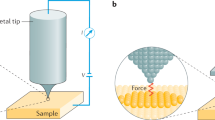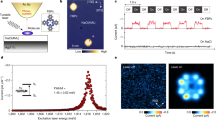Abstract
THE scanning tunnelling microscope (STM) is now an established tool for the study of ordered metal and semiconductor surfaces on an atomic scale1,2. Here we demonstrate the ability of the STM to image a large class of organic molecular adsorbates with almost atomic resolution3. From the images it is apparent that not only is the STM resolving the individual molecules, but it is also distinguishing between the different functional groups within the molecules. We propose that the contrast mechanism responsible for the well resolved images is modulation of the local work function of the substrate by the polarizable molecular adsorbates.
This is a preview of subscription content, access via your institution
Access options
Subscribe to this journal
Receive 51 print issues and online access
$199.00 per year
only $3.90 per issue
Buy this article
- Purchase on Springer Link
- Instant access to full article PDF
Prices may be subject to local taxes which are calculated during checkout
Similar content being viewed by others
References
Binnig, G. & Rohrer, H. Helv. phys. Acta 55, 726–735 (1982).
Binnig, G. & Rohrer, H. IBM Jl. Res. Dev. 30, 355–369 (1986).
Foster, J. S. & Frommer, J. E. Nature 333, 542–545 (1988).
Brownsey, G. J. & Leadbetter, A. J. Phys. Rev. Lett. 44, 1608–1611 (1980).
Leadbetter, A. J., Frost, J. C., Gaughan, J. P., Gray, G. W. & Mosley, A. J. Physique 40, 375–380 (1979).
Lang, N. D. Phys. Rev. B37, 10395–10398 (1988).
Weber, R. E. & Peria, W. T. Surf. Sci. 14, 13–38 (1969).
Antoniewicz, P. R. Phys. Rev. Lett 32, 1424–1425 (1974).
Antoniewicz, P. R. Surf. Sci. 52, 703–708 (1975).
Topping, J. Proc. R. Soc. A114, 67–72 (1927).
Robrieux, B., Faure, R. & Dussaulcy, J. P. C.R. Acad. Sci. Ser. B 278, 659–662 (1974).
Battezzatti, L., Pisani, C. & Ricca, F. J. chem. Soc. 71, 1629–1639 (1975).
Gland, J. L. & Somorjai, G. A. Surf. Sci. 38, 157–186 (1973).
Gimzewski, J. K. & Moller, R. Phys. Rev. B36, 1284–1287.
Lang, N. D. Phys. Rev. B38, 8173–8176 (1987).
CRC Handbook of Chemistry and Physics 66th Edn, E-70 (1985).
Crepeau, R. H. & Fram, E. K. Ultramicroscopy 16, 7–17 (1981).
Author information
Authors and Affiliations
Rights and permissions
About this article
Cite this article
Spong, J., Mizes, H., LaComb Jr, L. et al. Contrast mechanism for resolving organic molecules with tunnelling microscopy. Nature 338, 137–139 (1989). https://doi.org/10.1038/338137a0
Received:
Accepted:
Issue Date:
DOI: https://doi.org/10.1038/338137a0
This article is cited by
-
A switchable cantilver for a chemically sensitive scanning force microscope
Journal of Mechanical Science and Technology (2005)
-
2D self-assembling of 4, 5-didodecylthiolphthalonitrile on graphite surface
Chinese Science Bulletin (2003)
-
STM studies on adsorbed liquid crystal on HOPG
Science in China Series B: Chemistry (1998)
Comments
By submitting a comment you agree to abide by our Terms and Community Guidelines. If you find something abusive or that does not comply with our terms or guidelines please flag it as inappropriate.



